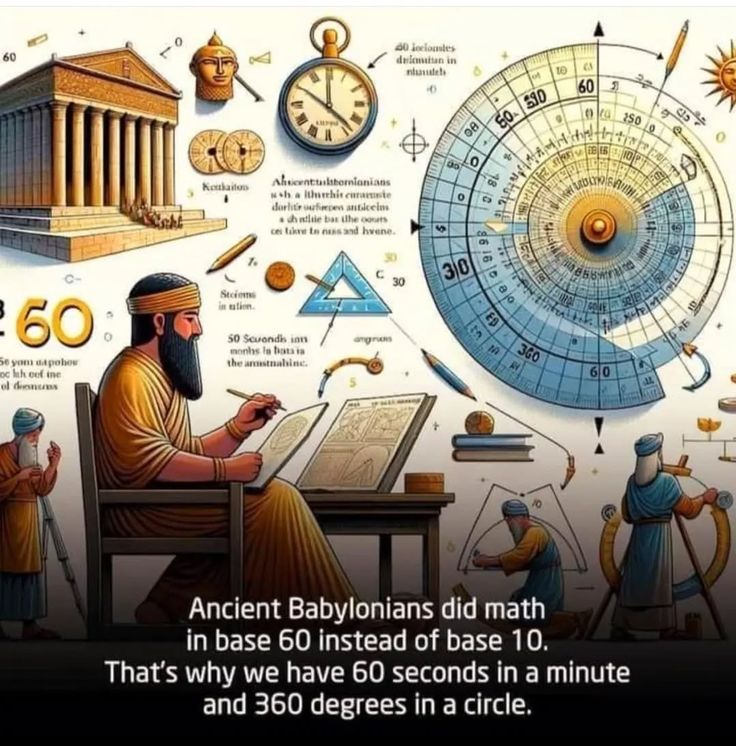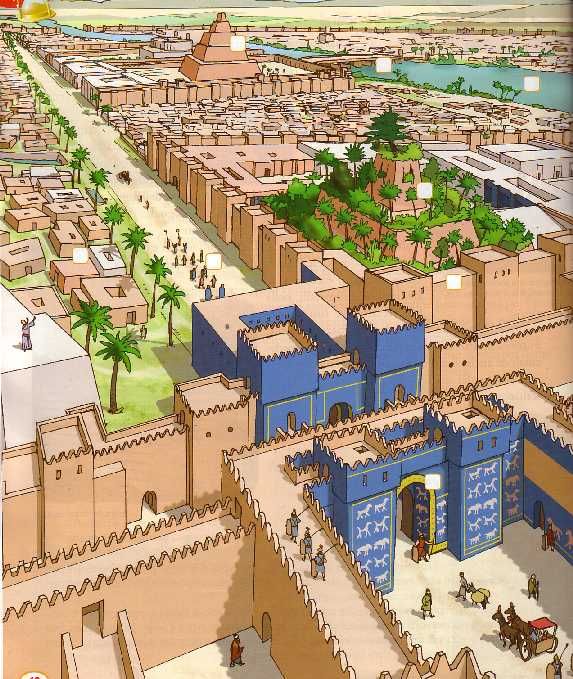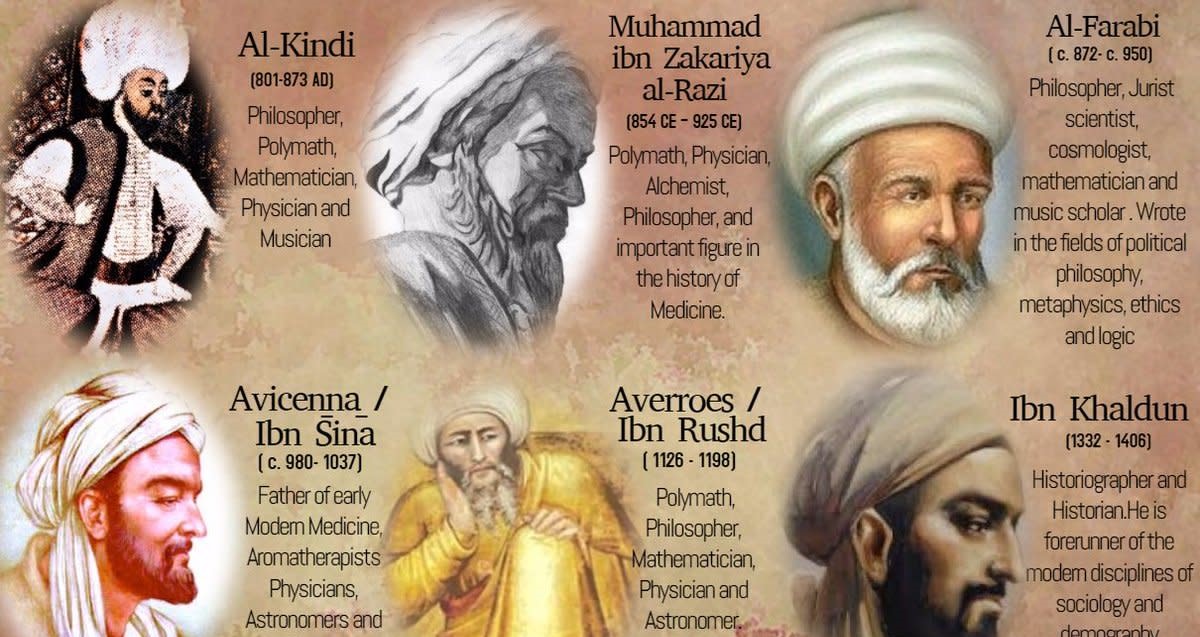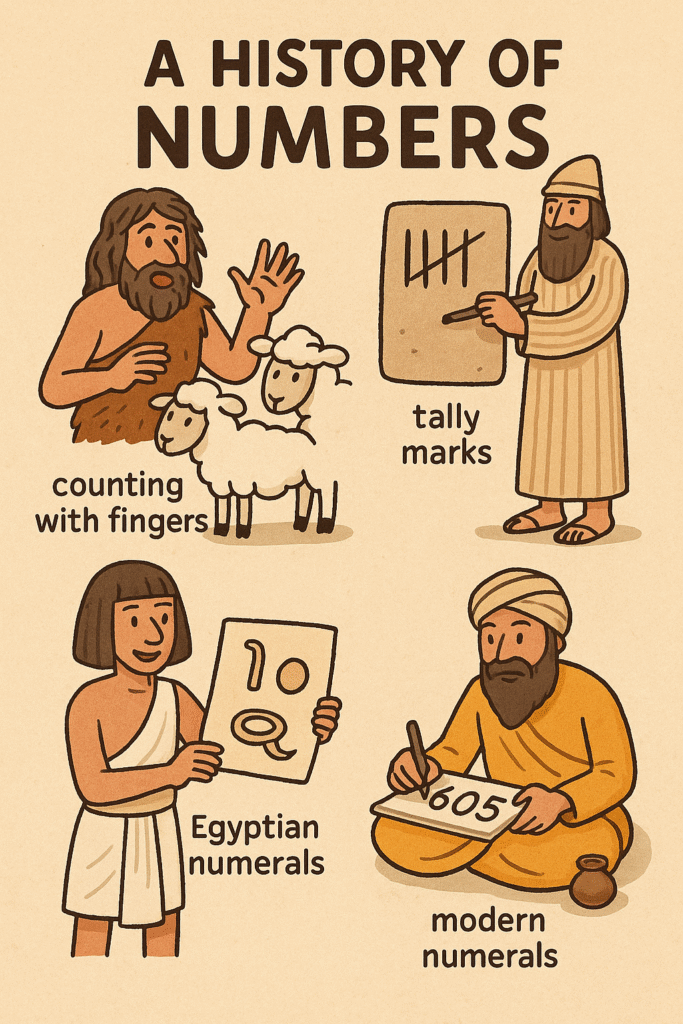📜 The Story of Numbers: From Qurūn-Ulā to Modern Math
For readers of mathgrammar.com
🌍 Imagine Life Without Numbers
Picture yourself thousands of years ago in the Qurūn-Ulā era (the earliest generations).
You’re a shepherd with goats 🐐. You know you had 12 goats yesterday… but when you return from the pasture, you’re not sure if all of them came back. How do you check?
👉 You grab a stick and carve a mark for each goat.
|||||||||||| = 12 goats
Congratulations! You’ve just used one of the first number systems: tally marks.
Thinking Point 💭: If you had 124 goats, how long would it take to carve all those lines?

🏺 Numbers Are Born in Ancient Civilizations (Qurūn-Ulā in action)
The Qurūn-Ulā, the earliest inventors of science, medicine, physics, and math, laid the first bricks of human knowledge.
Babylonians (Mesopotamia) : Invented a base-60 system. That’s why we have 60 minutes in an hour ⏱️ and 360 degrees in a circle.
Egyptians : Drew hieroglyphs for numbers. A coiled rope = 100, a lotus = 1,000. They needed geometry to build pyramids 🏗️.
Indus Valley :Created early place value and later gave us the greatest invention in math: zero (0).
Chinese : Used counting rods and later the abacus, and even played with negative numbers for debts.

 The Missing Hero: Zero
The Missing Hero: Zero
Let’s pause for a moment. Imagine trying to write the number 405 without zero.
In Roman numerals, it would look like: CDV.
But how would you easily multiply it? Exactly … not so simple!
Enter Brahmagupta (7th century):
Defined zero as a number.
Gave rules for adding and subtracting with zero.
This single idea powered modern math, computers, and even your smartphone.
Fun Question 
✨ The Golden Age of Numbers (Islamic World, 8th to 14th Century)
Fast-forward to Baghdad, the House of Wisdom. Scholars here translated, preserved, and expanded ancient knowledge.
Al-Khwārizmī : Father of al-jabr (algebra) and “algorithms.” Without him, Google search wouldn’t exist!
Al-Uqlīdisī : Introduced decimal fractions (imagine trying to calculate 1/3 without them).
Al-Bīrūnī :Used math for geography and astronomy 🌍.
Jamshīd al-Kāshī : Calculated π (pi) to incredible accuracy with decimals.
These scholars made the Hindu-Arabic numerals (0–9) global. That’s why today you don’t write numbers as “XIV” or “𓎆𓏺𓏺𓏺” but simply 14.



Fibonacci Brings It to Europe
In 1202, an Italian merchant’s son named Leonardo of Pisa (Fibonacci) published Liber Abaci.
He showed European traders how much easier calculations were with Hindu-Arabic numerals compared to Roman numerals.
Roman numerals: LXXXVII × IX (87 × 9) 😖
Hindu-Arabic numerals: 87 × 9 = 783 😎
Fibonacci also introduced the famous Fibonacci sequence: 1, 1, 2, 3, 5, 8… which appears in sunflowers 🌻 and seashells 🐚.
🚀 Modern Numbers: Infinity, Negatives & Imaginary
As time passed, people asked bigger questions:
What if numbers go below zero? (→ negatives)
Can numbers go on forever? (→ infinity)
What if we take √-1? (→ imaginary numbers)
Strange? Yes. But today, these “weird numbers” power electricity ⚡, GPS, AI, and even quantum physics.
🧮 Numbers Today
Every digital device runs on binary numbers (0s and 1s).
Your laptop 💻 = billions of 0s and 1s flipping every second.
Your TikTok feed or YouTube recommendations? Math in action.
The future? Quantum numbers may run the computers of tomorrow.

✍️ Quick Quiz (for you, dear reader!)
Which civilization gave us base-60 (time & angles)?
Who first defined zero as a number?
Why did Fibonacci promote Hindu-Arabic numerals in Europe?
Answers:
1 → Babylonians, 2 → Brahmagupta, 3 → They made trade and calculation faster & easier.

💡 Final Thought
Numbers are more than symbols they are human inventions that tell the story of survival, trade, curiosity, and imagination.
From Qurūn-Ulā carving tallies on bone, to Al-Khwārizmī shaping algorithms, to modern AI the journey of numbers is really the journey of us all.
👉 Keep exploring at mathgrammar.com, where math becomes easy.
